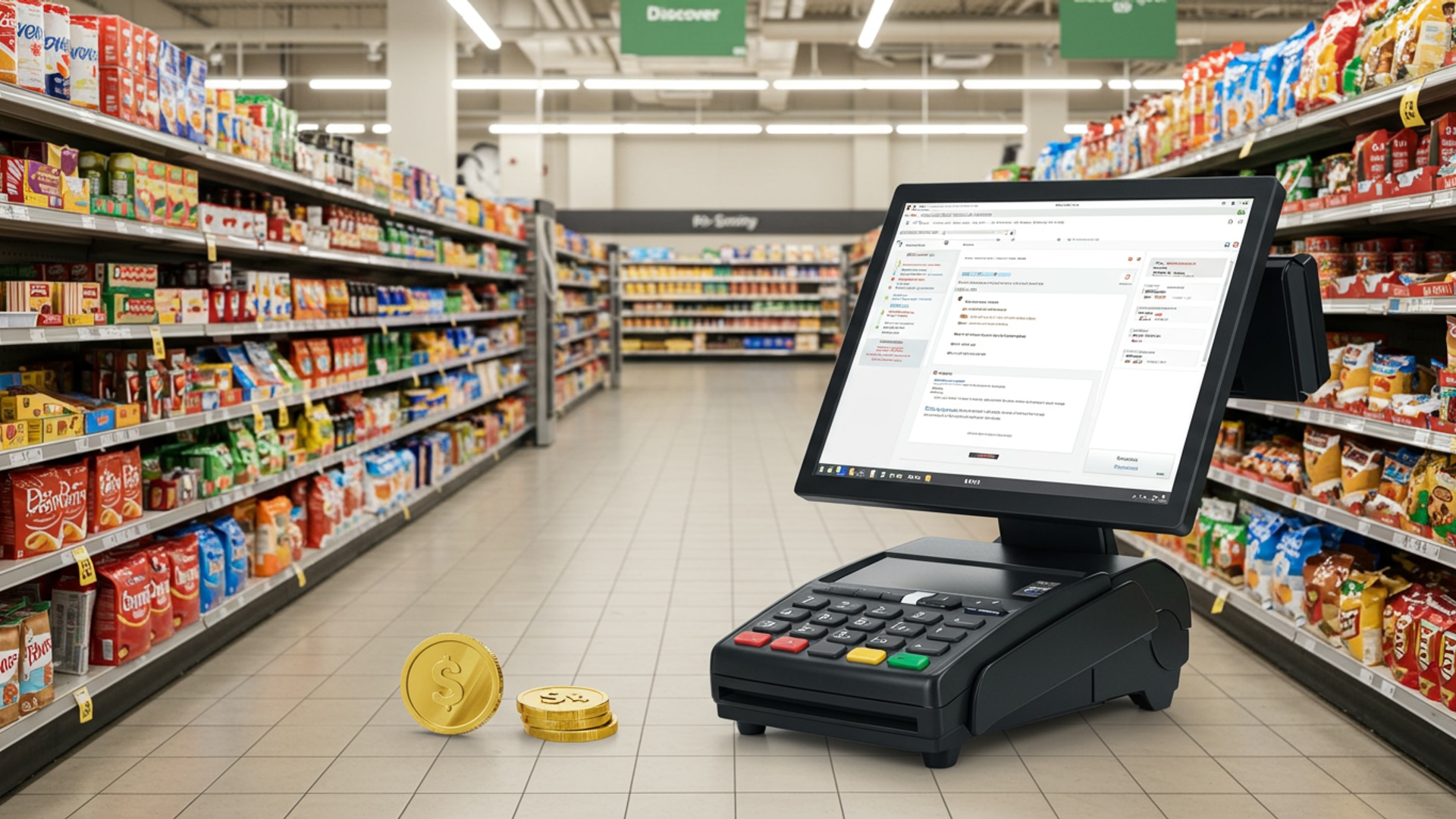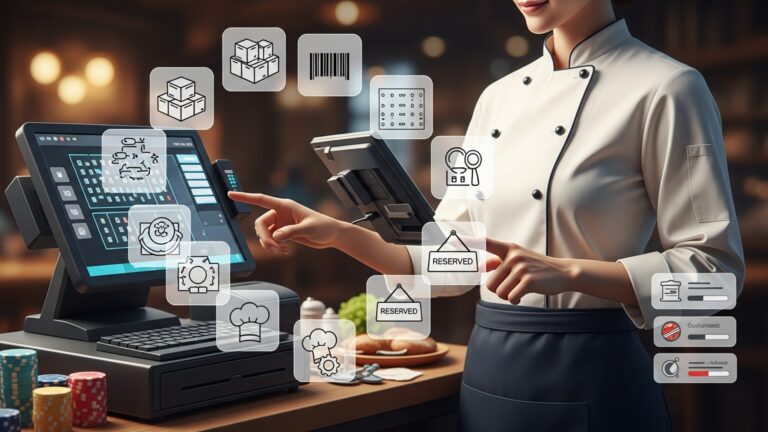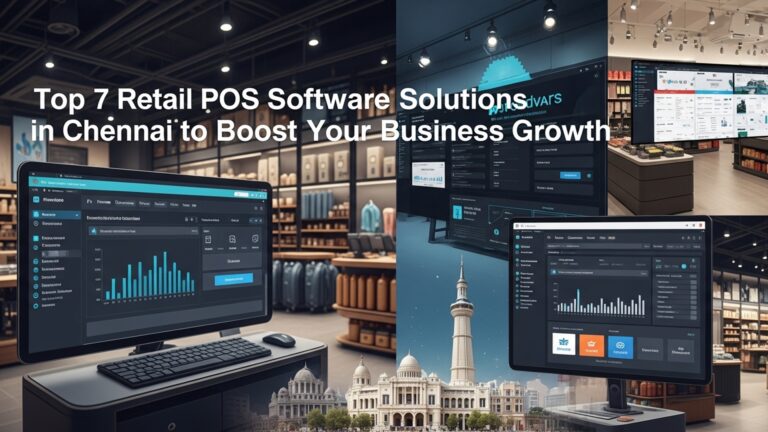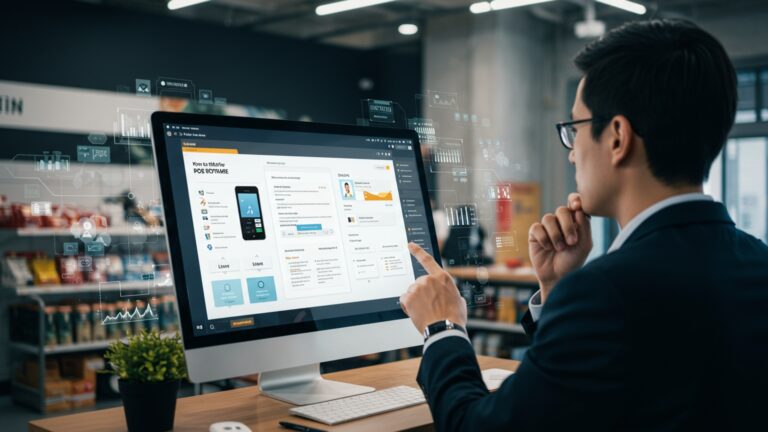Discover 7 Budget-Friendly POS Software for Every Grocery Store Business
Grocery stores navigate an increasingly complex retail environment, where razor-thin margins and dynamic customer expectations demand operational excellence. The right Point-of-Sale (POS) system transforms daily transactions into powerful data streams. finding an affordable, robust solution remains a critical challenge. Modern cloud-based platforms now offer sophisticated inventory management, integrated loyalty programs. essential contactless payment processing without the hefty traditional price tags. Businesses often seek the cheapest POS software for grocery operations, yet true value emerges from systems that deliver high functionality—like real-time stock tracking to minimize spoilage or automated reordering—at an accessible price point. Optimizing checkout efficiency and back-end processes directly impacts profitability in today’s competitive market.

Understanding POS Software for Grocery Stores
In the bustling world of grocery retail, efficiency is paramount. A Point of Sale (POS) system is no longer just a cash register; it’s the central nervous system of your operation. For grocery stores, a robust POS system facilitates transactions, manages inventory, tracks sales. even helps with customer loyalty programs. It’s the technology that connects every purchase to your back-end operations, ensuring smooth sailing from checkout to stockroom.
A POS system for a grocery store is specifically designed to handle the unique challenges of the industry, such as high transaction volumes, perishable goods, weight-based pricing. intricate inventory management. It streamlines operations, reduces errors. provides valuable insights into your business performance.
When we talk about “budget-friendly” POS software, we’re referring to solutions that offer essential functionalities without breaking the bank. This doesn’t necessarily mean sacrificing quality or critical features. Instead, it often implies flexible pricing models, scalable plans, or core functionalities that cover the most pressing needs of small to medium-sized grocery businesses. Finding the cheapest POS software for grocery that still meets your operational demands is a smart business move, especially for new or growing stores looking to optimize costs while enhancing efficiency.
Key Features to Look for in Budget-Friendly Grocery POS
Even with a limited budget, certain features are non-negotiable for a grocery store POS system. Prioritizing these functionalities will ensure your investment genuinely supports your business growth.
-
- Inventory Management
This is arguably the most critical feature for grocery stores. Your POS should allow for real-time tracking of stock levels, managing product variations (e. g. , different weights or sizes), handling returns. integrating with your suppliers for automated reordering. It should support FIFO (First-In, First-Out) tracking for perishables and offer tools to minimize waste.
-
- Barcode Scanning
Essential for quick and accurate checkouts. The system should integrate seamlessly with various barcode scanners, allowing for rapid product identification and pricing, reducing manual entry errors. speeding up customer service.
-
- Payment Processing
A good POS system must support a variety of payment methods, including credit/debit cards, contactless payments (NFC), mobile payments. potentially EBT/SNAP. Look for systems with integrated payment processing to simplify reconciliation and potentially reduce transaction fees.
-
- Customer Management & Loyalty Programs
Building customer loyalty is vital. A budget-friendly POS should enable you to capture customer data, track purchase history. implement simple loyalty programs (e. g. , points systems, discounts) to encourage repeat business.
-
- Reporting & Analytics
Understanding your sales data, peak hours, most popular products. employee performance is crucial for making informed business decisions. Even the cheapest POS software for grocery should offer basic sales reports, inventory reports. employee performance metrics.
-
- Scalability
As your grocery store grows, your POS system should be able to grow with it. Look for solutions that offer different plans or add-on modules, allowing you to upgrade features as your needs evolve without having to switch systems entirely.
-
- Ease of Use
A user-friendly interface is crucial for quick staff training and efficient operations. Your employees should be able to navigate the system with minimal effort, reducing checkout times and improving customer satisfaction.
7 Budget-Friendly POS Software Options for Grocery Stores
Navigating the vast landscape of POS solutions can be daunting. Here are seven budget-friendly options that cater to the specific needs of grocery store businesses, offering a blend of essential features and cost-effectiveness.
1. Square for Retail
-
- Description
Square is renowned for its user-friendly interface and comprehensive ecosystem. Square for Retail is tailored specifically for retail businesses, making it a strong contender for grocery stores. It offers robust inventory management and integrated payment processing.
-
- Key Features for Grocery
Advanced inventory management (tracking by item, variant, category), vendor management, purchase orders, barcode label printing, customer directories. integrated online store options. Its intuitive design makes it easy for staff to learn quickly.
-
- Pricing Model
Square offers a free plan with basic POS features and standard processing rates. Paid plans (Plus and Premium) unlock more advanced retail-specific features, starting around $29/month per location, plus transaction fees. This makes it a strong candidate if you’re looking for the cheapest POS software for grocery to get started.
-
- Pros
Easy setup, excellent hardware integration, transparent pricing, strong inventory tools, integrated payments.
-
- Cons
Advanced features require a paid subscription, transaction fees can add up with high volume, may require additional apps for very specific grocery needs (e. g. , weight scale integration for certain items).
2. Loyverse POS
-
- Description
Loyverse offers a free POS application for small businesses, making it incredibly appealing for those prioritizing cost savings. It focuses on essential retail functionalities with optional paid add-ons.
-
- Key Features for Grocery
Inventory management (including item variants), barcode scanning, customer loyalty programs, sales analytics. employee management. It supports multiple payment types and offers a kitchen display system (KDS) which can be adapted for deli/bakery counters.
-
- Pricing Model
The core POS app is free. Optional paid add-ons include advanced inventory, employee management. integrations, typically starting around $25/month per store for each add-on. Payment processing is separate.
-
- Pros
Truly free core POS, simple and intuitive interface, good for small grocery stores, supports Android and iOS devices.
-
- Cons
Advanced features cost extra, limited third-party integrations, customer support can be slower for free users.
3. eHopper POS
-
- Description
eHopper is a comprehensive POS solution designed for various retail and restaurant businesses. It offers a free plan and affordable paid options, often including hardware bundles.
-
- Key Features for Grocery
Inventory management (including modifier support for items like custom sandwiches), barcode scanning, customer management, employee management. robust reporting. It also offers offline mode capability.
-
- Pricing Model
Offers a “Free Essential” plan with basic POS features. Paid plans (Freedom, Unlimited) unlock advanced features like advanced inventory, loyalty programs. more comprehensive reporting, starting around $29. 99/month. They often provide free POS hardware with certain plans.
-
- Pros
Free tier available, often includes hardware incentives, good for small to medium-sized grocery stores, strong inventory and reporting.
-
- Cons
The free plan is quite basic, some features like loyalty are only on higher tiers, user interface can be less polished than some competitors.
4. Odoo POS (Community Edition)
-
- Description
Odoo is an all-in-one business management software with a powerful POS module. Its Community Edition is open-source, offering significant flexibility for tech-savvy users or those with development resources.
-
- Key Features for Grocery
Comprehensive inventory management, multi-store support, barcode scanning, customer management. integration with other Odoo modules (CRM, accounting, e-commerce). It supports weight-based products and custom layouts.
-
- Pricing Model
The Community Edition is free to download and use. requires self-hosting and configuration. The Enterprise Edition (cloud-based with more features and support) starts from $24/user/month (billed annually), plus app fees. For those willing to manage the technical aspects, the Community Edition can be the cheapest POS software for grocery.
-
- Pros
Highly customizable, no license fees for Community Edition, integrates with a full suite of business tools, robust for growing businesses.
-
- Cons
Requires technical expertise for setup and maintenance (Community Edition), steep learning curve, Enterprise Edition can become costly with many users/apps.
5. Shopify POS Lite
-
- Description
Ideal for grocery stores that also have an online presence (or plan to create one). Shopify POS Lite seamlessly integrates your in-store and online sales, providing a unified platform.
-
- Key Features for Grocery
Syncs online and in-store inventory, barcode scanning, basic customer profiles, gift cards. email cart recovery. It allows for easy product creation and management, crucial for a diverse grocery inventory.
-
- Pricing Model
Included with all Shopify plans, which start from $29/month for the Basic Shopify plan (billed annually), plus transaction fees. This makes it a compelling option for hybrid online/offline grocery businesses.
-
- Pros
Excellent for omnichannel retail, easy to use, robust e-commerce integration, reliable platform.
-
- Cons
Requires a Shopify e-commerce plan, advanced POS features (like staff permissions or detailed reporting) are in the more expensive POS Pro version ($89/month per location), transaction fees apply unless using Shopify Payments.
6. KORONA POS
-
- Description
KORONA POS is a robust cloud-based POS system designed specifically for retail, with strong capabilities for grocery stores, including features for inventory, analytics. customer management.
-
- Key Features for Grocery
Comprehensive inventory management (including expiration dates, batch tracking, composite items), detailed reporting and analytics, integrated time clock, loyalty programs. support for various hardware including scales. It’s built to handle high volume.
-
- Pricing Model
KORONA POS offers tiered pricing plans, starting from around $49/month. They often provide a free trial. While not the absolute cheapest upfront, its comprehensive feature set for grocery makes it a budget-friendly value proposition for serious retailers.
-
- Pros
Highly specialized for retail, excellent inventory control, strong reporting, scalable for growing grocery stores, good for multi-location businesses.
-
- Cons
Higher starting price than some entry-level options, can have a steeper learning curve due to its depth of features.
7. Clover Station Solo/Mini
-
- Description
Clover offers an ecosystem of sleek, all-in-one POS hardware and software solutions. The Clover Station Solo or Mini are excellent choices for grocery stores looking for integrated hardware and a streamlined checkout experience.
-
- Key Features for Grocery
Intuitive touchscreen interface, integrated payment processing, basic inventory tracking, employee management. access to a vast app market for additional functionalities (e. g. , advanced inventory, loyalty). Supports weight scales and barcode scanners.
-
- Pricing Model
Clover’s pricing typically involves a hardware purchase (e. g. , Clover Mini starts around $799 or can be leased) plus a monthly software plan, starting from around $14. 95/month for the “Register Lite” plan (plus payment processing fees). While the hardware is an initial investment, the monthly software can be budget-friendly.
-
- Pros
All-in-one integrated hardware and software, user-friendly interface, strong security, extensive app market for customization.
-
- Cons
Higher initial hardware cost, requires a monthly software plan, primarily tied to specific payment processors, app market can lead to additional costs.
Comparison Table: Choosing Your Ideal Grocery POS
To help you decide which budget-friendly POS software for grocery best suits your needs, here’s a comparative overview of the options discussed:
| Feature/Software | Square for Retail | Loyverse POS | eHopper POS | Odoo POS (Community) | Shopify POS Lite | KORONA POS | Clover Station Solo/Mini |
|---|---|---|---|---|---|---|---|
| Starting Price (Monthly) | Free (basic), $29 (Plus) | Free (core), $25/add-on | Free (Essential), $29. 99 (Freedom) | Free (self-hosted), $24/user (Enterprise) | $29 (with Shopify plan) | $49 | $14. 95 (software), plus hardware |
| Inventory Management | Strong, variants, vendors | Good, variants | Good, modifiers | Excellent, highly customizable | Good, online sync | Excellent, batch, expiry | Basic, expandable via apps |
| Barcode Scanning | Yes | Yes | Yes | Yes | Yes | Yes | Yes |
| Payment Processing | Integrated Square Payments | Separate providers | Integrated & separate | Integrated & separate | Shopify Payments (recommended) | Integrated & separate | Integrated Clover Payments |
| Customer Loyalty | Yes (paid plan) | Yes (paid add-on) | Yes (paid plan) | Yes (via modules) | Basic profiles, gift cards | Yes | Yes (via apps) |
| Reporting & Analytics | Good | Good | Good | Excellent (with other Odoo modules) | Basic | Excellent | Good, expandable via apps |
| Ease of Use | High | High | Medium-High | Medium (Community) | High | Medium | High |
| Scalability | High | Medium | Medium-High | Very High | High | High | High |
| Best For | Small-medium grocery, new businesses | Very small grocery, cost-conscious | Small-medium grocery, hardware needs | Tech-savvy, growing grocery, full suite needs | Grocery with online store | Medium-large grocery, specialized retail | Grocery needing integrated hardware, sleek design |
Actionable Steps: Selecting the Right POS for Your Grocery Store
Choosing the right POS system is a critical decision for your grocery store’s long-term success. Here are actionable steps to guide you through the selection process, ensuring you find the cheapest POS software for grocery that truly fits your operations.
-
- Assess Your Specific Needs
Before looking at any software, make a detailed list of your grocery store’s unique requirements. Do you sell items by weight? Do you need to manage produce, perishables, or deli counters? What payment methods are crucial? How many employees will use the system. what level of permissions do they need? Understanding these specifics will narrow down your options significantly.
-
- Define Your Budget (and stick to it)
Budget-friendly means different things to different businesses. Determine your maximum acceptable monthly software cost, including potential transaction fees and any necessary hardware investments. Remember to factor in the total cost of ownership over time, not just the initial price. The cheapest POS software for grocery isn’t always the best if it lacks critical features you’ll eventually need.
-
- Prioritize Essential Features
While a comprehensive feature set is appealing, focus on the core functionalities that will deliver the most value to your grocery store. Inventory management, quick checkout. reliable payment processing should be at the top of your list. You can always add more advanced features later if the system is scalable.
-
- Test Drive Demos and Free Trials
Most reputable POS providers offer free trials or demos. Take advantage of these to experience the software firsthand. Run mock transactions, test inventory management. see how easy it is for your staff to use. This hands-on experience is invaluable in making an informed decision.
-
- Read Reviews and Seek Recommendations
Look for reviews from other grocery store owners or similar retail businesses. Pay attention to comments regarding customer support, reliability. specific grocery-related features. Online forums, business communities. professional networks can provide valuable insights.
-
- Consider Scalability and Future Growth
Your grocery store might be small now. you likely have plans for growth. Choose a POS system that can scale with you, offering upgrades or add-ons for additional features, locations, or higher transaction volumes, without forcing a complete system overhaul.
-
- Evaluate Customer Support
Even the most intuitive software can have its moments. Reliable and accessible customer support is crucial. Check what support channels are available (phone, email, chat), their operating hours. if there are additional costs for premium support.
Conclusion
Choosing the right budget-friendly POS isn’t just about saving money; it’s about smart growth for your grocery store. You’ve seen that powerful features don’t always demand a hefty price tag. My personal tip? Don’t just pick one based on price; prioritize features that genuinely solve your daily operational headaches, like efficient inventory tracking or swift customer checkout, which significantly impacts customer flow and reduces queues. In today’s fast-evolving retail landscape, with consumers increasingly expecting seamless transactions and loyalty programs, a modern, affordable POS is no longer a luxury but a necessity. I’ve noticed how even small upgrades, like adopting a cloud-based system, can dramatically improve efficiency and staff morale. Remember, the goal is to streamline operations, reduce waste. ultimately boost your bottom line. For more insights on cost-effective solutions, consider exploring options like those discussed in the Guide to the 10 Cheapest POS Software for Grocery Store Owners. Take the leap; your grocery store deserves a system that empowers it to thrive in the competitive market.
More Articles
Guide to the 10 Cheapest POS Software for Grocery Store Owners
Discover the 7 Best POS Software Solutions for Your Kirana Store Business
How to Choose and Use a POS System for Inventory Management in India
Compare POS Software Price in India 5 Essential Factors to Know
Unlock Growth with 7 Essential Free POS Software Options for Small Businesses
FAQs
What exactly is POS software for a grocery store?
It’s the system that helps you ring up sales, process payments. manage your daily store operations. Think of it as the brain behind your checkout counter. it does a lot more, like tracking what you sell and keeping an eye on your stock.
My grocery store is small, why should I bother with a POS system?
Even for a small store, a POS system can save you a ton of time and hassle. It speeds up checkout, makes inventory tracking way easier, helps you spot popular products. can even reduce errors. It’s about making your business run smoother and smarter.
Are these budget-friendly POS options reliable, or are they just cheap and lacking?
Absolutely, many budget-friendly POS options are very reliable! ‘Budget-friendly’ often means they’re designed with core functionalities in mind, avoiding super high-end features you might not need. They’re built to be effective and robust for typical grocery store needs without breaking the bank.
What are the must-have features I should look for in a POS system for my grocery business?
For groceries, you’ll definitely want solid inventory management (especially for perishable goods), quick checkout processing, barcode scanning, flexible payment processing. some basic reporting to see what’s selling. Customer management and loyalty programs are also a big plus if you want to keep shoppers coming back.
I’m not super tech-savvy. Is it tough to set up and learn these budget POS systems?
Most modern budget-friendly POS systems are designed with ease of use in mind. Many offer intuitive interfaces and straightforward setup processes. You can often get up and running pretty quickly. a lot of providers have good online resources or support to help you learn the ropes.
Can these budget POS systems actually handle the complex inventory of a grocery store, especially with fresh produce and varying weights?
Yes, many are equipped for it! Look for systems that support detailed inventory tracking, including items sold by weight, expiration dates. different unit types. While some might have more advanced features than others, the good ones will definitely help you keep tabs on your diverse grocery stock.
Beyond the initial purchase, what kind of ongoing costs should I expect with a budget-friendly POS system?
Typically, you’ll have a recurring monthly or annual subscription fee for the software itself. You might also have payment processing fees, which vary by provider. Some systems might have optional add-ons or premium support plans that cost extra. the core budget systems aim to keep these ongoing expenses predictable and manageable.






